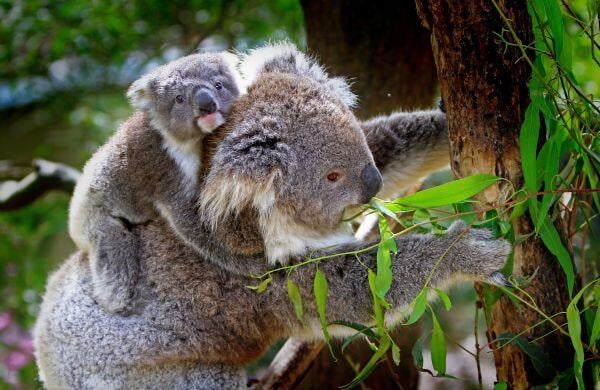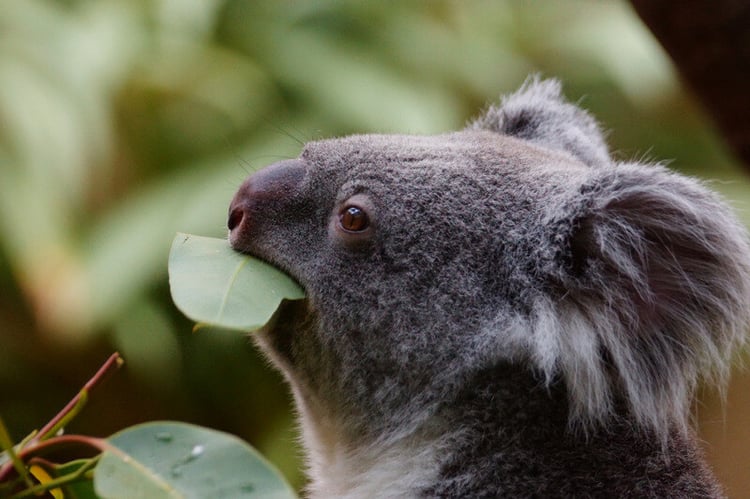Koalas
Overview of Koalas
Koalas are solitary animals found across a wide range of habitats, from cool temperate forests to tropical regions. They are one of Australia’s most iconic native species and play a vital role in the health of eucalypt ecosystems.
Extinction Risk
Once widespread throughout Australia’s eucalypt forests and woodlands, koalas have experienced severe population declines. In 2022, koalas were officially listed as Endangered in Queensland, New South Wales and the ACT, following decades of habitat destruction, disease, and natural disasters. The species remains Vulnerable to Extinction on the IUCN Red List.
In the early 1900s, koalas were almost hunted to extinction, with around 8 million killed for the fur trade. Since then, land clearing for residential, agricultural, and industrial development has destroyed large areas of their natural habitat. The devastating 2019–2020 bushfires killed tens of thousands of koalas and destroyed vast areas of forest. A government inquiry in 2020 warned that without urgent intervention, koalas could become extinct in NSW by 2050.
While koalas in Victoria and South Australia are not currently listed as threatened, they face many of the same pressures as populations in other states.
Key Threats
-
Habitat loss and fragmentation
-
Reduced genetic diversity
-
Disease, including chlamydia
-
Vehicle collisions
-
Dog attacks
-
Climate change impacts


Koala Characteristics & Behaviour
Koalas have thick fur for protection, large round furred ears, and a distinctive dark leathery nose. They rely heavily on their sharp sense of smell and hearing to detect suitable food sources.
Koalas spend up to 20 hours a day resting in the forks of trees, conserving energy for feeding. They are most active at night, particularly at dusk and pre-dawn, when they forage on eucalyptus leaves. Although they have been observed feeding on over 120 species of eucalypts, each koala relies on a handful of preferred species in its home range. On average, they eat around half a kilogram of leaves daily and obtain most of their water from their food.
Despite their quiet appearance, koalas are vocal animals, producing bellows, grunts, growls, and wails, especially during the breeding season. They are skilled climbers and can move quickly on the ground when threatened.
Breeding
Koalas breed during spring and summer, with young born around one month after mating. Newborn koalas, known as joeys, are tiny — about the size of a bee — and spend their first 13 weeks developing inside their mother’s downward-opening pouch.
At around seven months old, joeys leave the pouch and begin riding on their mother’s back, though they continue to return to the pouch to suckle. By 12 months, they are fully weaned and independent.
Females usually reach sexual maturity at around two years of age, while males mature later, at approximately three to four years.
WIRES Impact
WIRES plays a vital role in the rescue, rehabilitation, and protection of koalas nationwide. Our work includes:
-
Providing 24/7 rescue advice and assistance for around 800 koalas annually
-
Attending over 1,200 rescues in Queensland since 2020
-
Building and operating dedicated koala rehabilitation facilities
-
Training over 605 participants in koala rescue since 2022
-
Investing over $5 million into critical koala projects, including:
-
Supporting the Koala Health Hub and wildlife medicine research at The University of Sydney
-
Delivering the Water for Wildlife Project
-
Partnering with Landcare on 13 habitat projects across three states
-
Launching WildSeek with Landcare and Queensland University of Technology, a community-driven koala conservation initiative
-
Partnering with the Total Environment Centre to launch the Sydney Basin Koala Network
-
-
Expanding national research and conservation efforts through the WIRES Research Grant Program, WIRES National Grant Program and other national funding streams.
How You Can Help
-
If you see a koala in danger, or one that is sick, injured, or orphaned, contact your local wildlife rescue organisation, or call WIRES on 1300 094 737 or complete our online Rescue Form
-
Drive carefully in koala habitat areas, especially during breeding season (spring and summer).
-
Contain pets, particularly dogs, in areas where koalas live.
-
Spread awareness in your community about the threats koalas face and the importance of protecting their habitat.
-
Support WIRES’ work — your contribution helps us continue to improve emergency response, rescue, rehabilitation, release, research, and long-term koala conservation outcomes.
Report a Rescue
For wildlife rescue assistance you must call 1300 094 737 or fill in the Report a Rescue form. All other forms of contact including Facebook are not monitored for rescues.